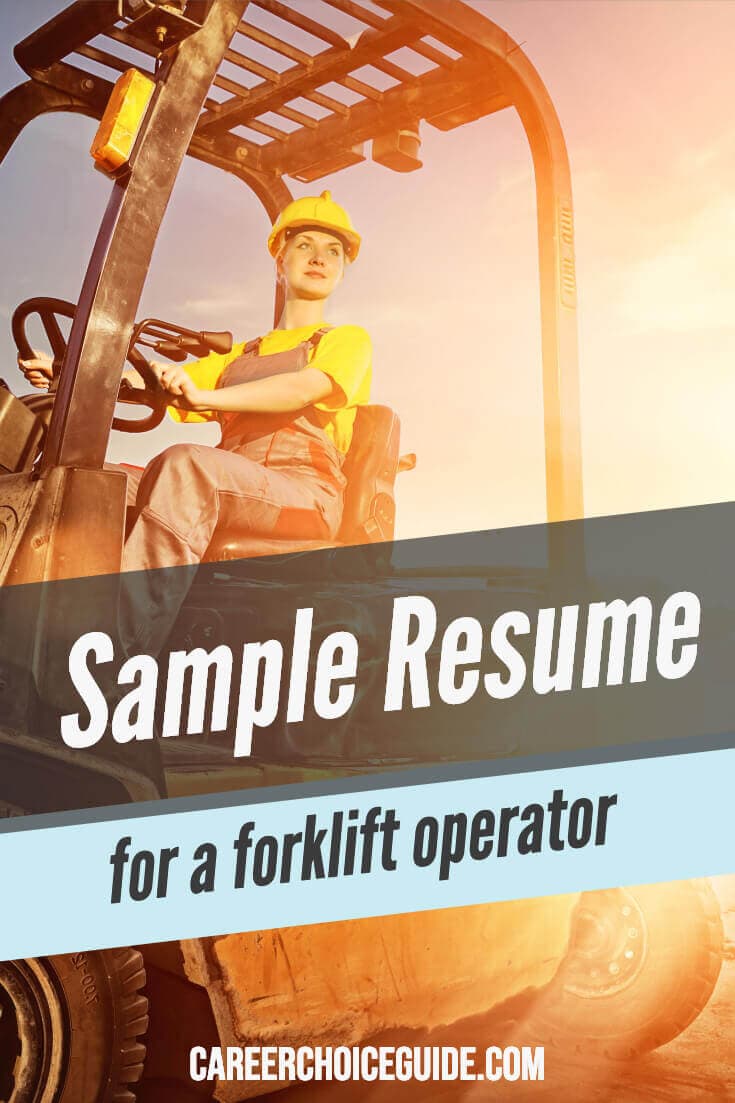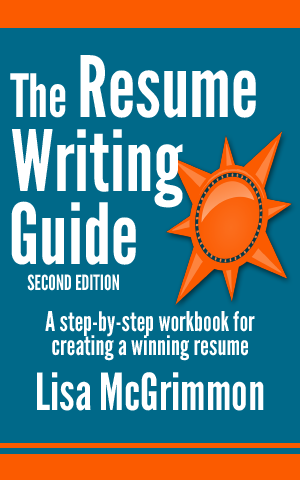Forklift Operator Resume Sample
Forklift operator resume sample shows you how to organize and format your resume when your most relevant experience is in the past.
This forklift operator resume sample will help with two concerns you may have:
If you're applying for a forklift operator job specifically, or a manufacturing job in general, you'll find key points employers in this field typically look for when they review resumes. You can take ideas from the sample resume and rephrase them so they are written in your own words and reflect your unique experience and skills.
If you're applying for any type of job at all, and your most relevant experience is in the past, you'll learn how to get the most important information up to the top of your resume where employers will see it immediately.
Here's what you'll find on this page:
- Key resume writing concerns when your relevant experience is in the past
- 5 resume writing strategies to use when your relevant experience is in the past
- Forklift operator resume sample
- Why this forklift operator resume works
The sample resume you'll see farther down the page details the skills and experience of a job seeker who has six years of experience working as a forklift operator. He lost his job in manufacturing, and he took a job as a retail sales associate at a building supply store. He would like to find work as a forklift operator again.
His example resume shows how he can highlight his experience as a forklift operator even though he is currently working at a different type of job.
Key Resume Writing Concerns to Address When Your Relevant Experience is in the Past
If your most relevant experience for a specific type of job is in the past, when write your resume, your biggest challenge will be ensuring employers see that relevant experience first as they review your resume.
You'll need to find ways to present yourself as an ideal candidate for a job you did at some time in the past and minimize your current job if it is unrelated.
You'll need to use strategies to:
- Move your more relevant job(s) to the top of your resume, even if you've held less relevant jobs more recently.
- Highlight skills and experience related to the job you are currently seeking, which may be different from your current (or most recent) job.
- Avoid giving the impression that your most relevant skills are out of date.
The sample forklift operator resume on this page will show you exactly how to achieve those goals.
5 Resume Writing Strategies to Use When Your Relevant Experience is in the Past
Five strategies you can use to write an effective resume when your most relevant experience is in the past:
- Use a combination resume format.
- Consider grouping your work history into two sections: relevant experience, and additional experience.
- Include thorough descriptions of your most relevant experience.
- Provide less information about your current (or most recent) job if it's not relevant to the job you're seeking.
- Format your resume to de-emphasize dates if your most relevant experience is more than six months in the past.
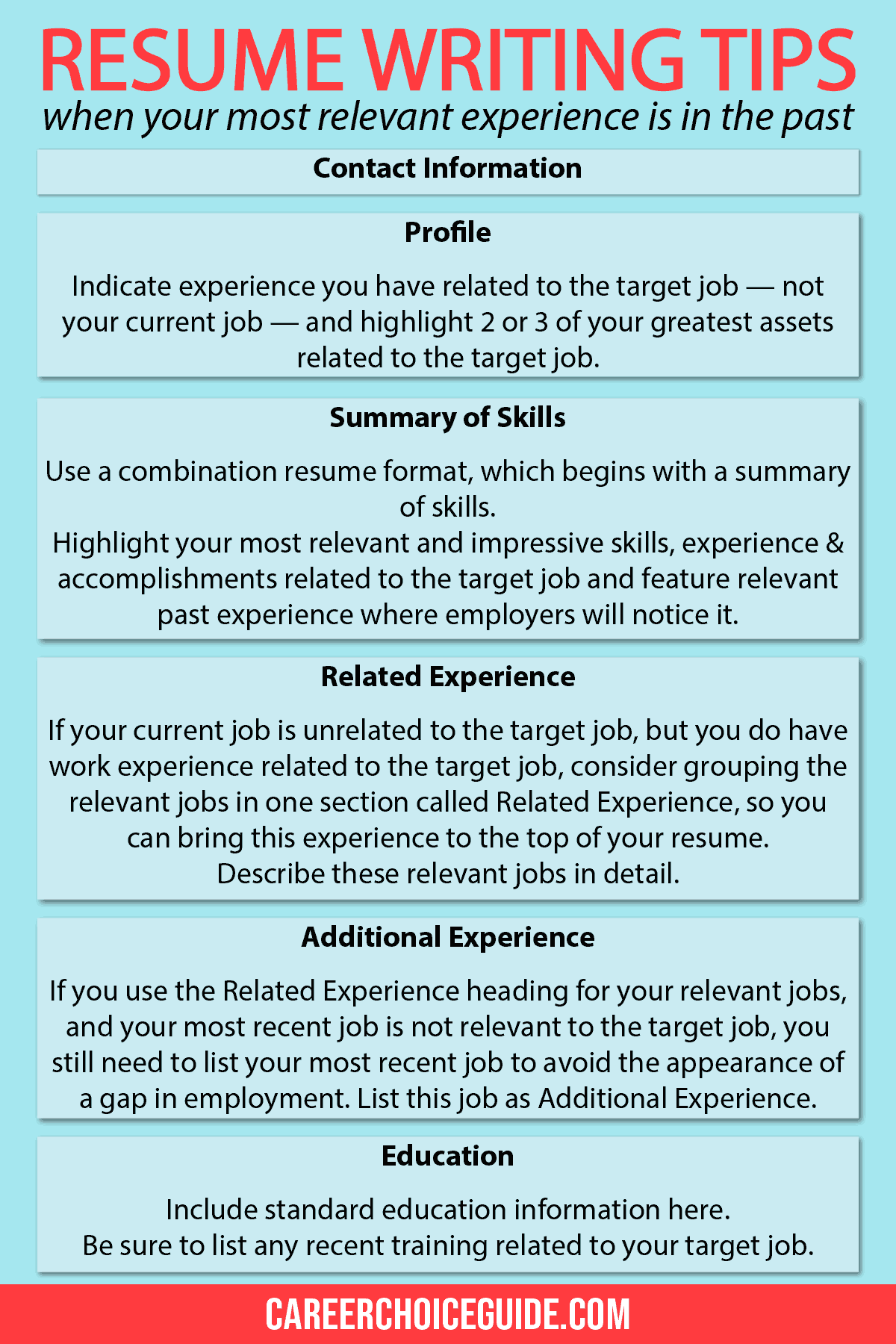
1. Use a combination resume format.
A combination resume format allows you to include a list of your most marketable skills and achievements at the top of your resume before you detail your work history. This summary of skills provides an excellent opportunity to list your most impressive skills and relevant experience at the top of your resume, where employers will notice them, even if you gained those skills and experience some time in the past.
The other common resume format, the chronological resume, makes your work history more prominent. You do need to show employers your relevant work experience, but if that experience is in the past, a combination resume will suit your needs better because it will allow you to highlight your skills first.
2. Consider grouping your work history into two sections: relevant experience, and additional experience.
Sometimes grouping your work history into two sections will help you move your most relevant experience to the top of your resume. This strategy can be a bit tricky, though. You'll need to use your best judgment to decide if it's the right strategy to use for your unique situation.
If your most relevant experience is in the past, but not too far in the past, this strategy can be effective.
Imagine the following scenario:
- It's 2021, and you're looking for a job as a forklift operator.
- You held that job at one company from 2014–2017, and at a second company from 2017–2021.
- You were laid off in early 2021.
- You took a job as a retail sales associate, but you would like to return to working as a forklift operator.
How would you format your work history to make sure employers see your relevant experience first?
You could group your work history into two sections — related experience, and additional experience — to get your most relevant experience up to the top of the resume.
Your resume would look something like this:
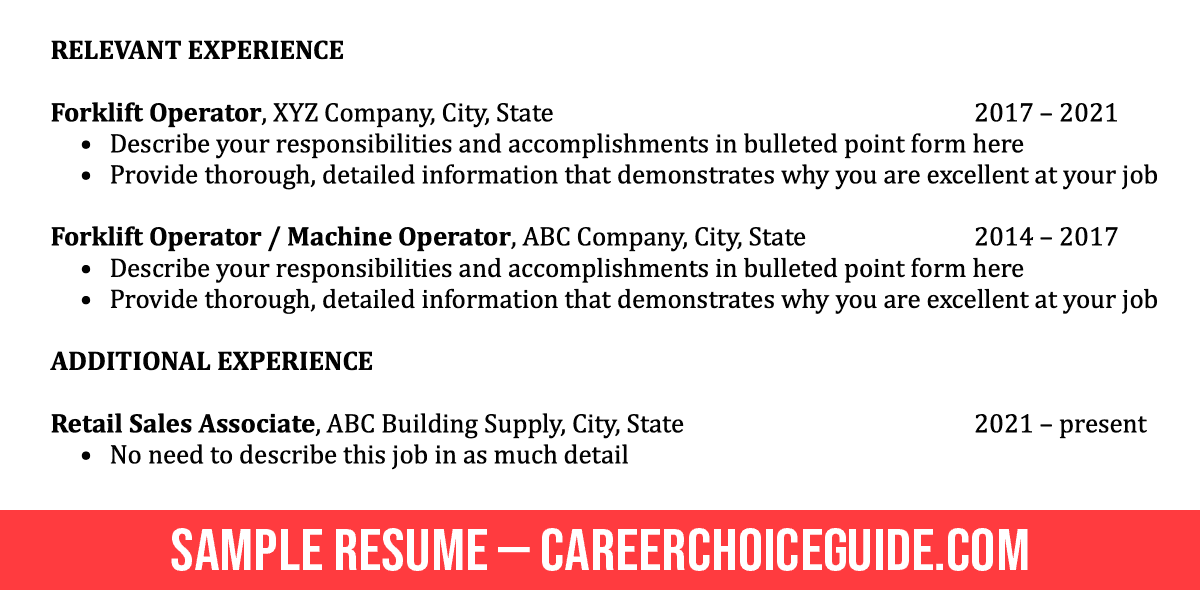
Notice, in the work history pictured above, the job seeker's most relevant experience was moved to the top of the resume in a section labeled Relevant Experience. Remember, this job seeker is targeting forklift operator jobs, so that's the experience he wants to emphasize on his resume.
The job seeker's current but less relevant job was moved to the bottom of the resume under the heading Additional Experience.
This arrangement allows the most relevant job to stand out while still showing that the job seeker is currently working. The employer will immediately see the job seeker has plenty of relevant work experience and will also know he is currently employed, which can make an individual a more attractive candidate in the minds of some employers.
If your most relevant experience goes back too far in the past, this strategy can backfire and should be avoided.
Imagine the same scenario described above. It's still 2021, and you're looking for a job as a forklift operator. But you were laid off from your last job working as forklift operator back in 2019. You've been working as a retail sales associate since 2020.
If you move your forklift operator job to the top of your resume, the first date employers will see is two years in the past. Scanning your resume quickly, an employer may not notice your current job listed farther down the resume. If, at first glance, you appear to have a big gap in your work history, employers will wonder what you've been doing in that time.
In this case, you need to put your current job first, so you don't create the perception that you have a big gap in your work history.
Your resume would look something like this:
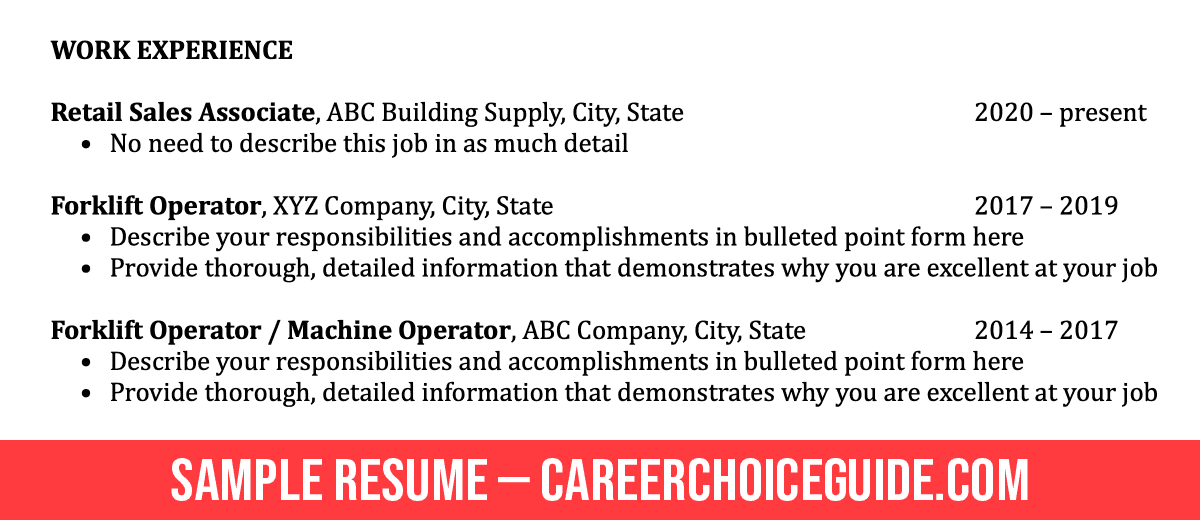
Using the headings Related Experience and Additional Experience to rearrange your work history can be useful in the right situations, but you do need to be very careful with this strategy.
If you are at all in doubt, don't get fancy. Simply list your work history in reverse chronological order. Include a lot of detail about the relevant jobs and less detail about the less relevant job.
3. Include thorough descriptions of your most relevant experience.
Describe, in detail, any past jobs that are relevant to the job you're targeting. Don't just describe what you did at your job. Write about accomplishments that demonstrate why you were good at your job.
4. Provide less information about your current (or most recent) job if it's not relevant to the job you're seeking.
If your current job does not require skills that are particularly relevant to the job you're targeting, there's no need to describe it in detail. Simply list your job title, the company name and location, and your employment dates.
You can add a point or two about the job if you like. Describing any responsibilities at your current job that demonstrate skills you would use to do the job you're targeting can be particularly helpful. However, if your past jobs are more relevant, and you've described them in detail, and your current job is vastly unrelated to the job you're applying to, if it not necessary to include any details about that job on your resume.
5. Format your resume to de-emphasize dates if your most relevant experience is more than six months in the past.
In general, if your employment experience is more than six months in the past, that gap can start to raise questions in the minds of employers. The specific time frame when employment gaps become an issue varies based on your industry and labor market conditions in your area, but six months is a good, general guideline.
If you have a gap in your work history that's larger than six months, you should use some simple strategies to minimize the appearance of dates on your resume.
When listing your work history, your job title and company information should go on the left side of the page. Your employment dates should go on the right side. Because we read from left to right, any entry on the left side of a page will be more immediately noticeable than entries on the right side of a page. This strategy is the easiest way to de-emphasize dates on your resume.
For most job seekers, including only the years you worked for each employer and omitting months is beneficial. Including months in your employment dates often exposes gaps in employment.
For example, imagine you worked from December 2019 to January 2021 at a particular job. If you are job searching in August 2021, you'll expose a six month gap in employment. If instead, you list your employment dates as 2019 – 2021, you avoid exposing the gap.
Forklift Operator Resume Sample
If you're looking for a forklift operator resume sample...
If you're looking specifically for ideas about what to include on a forklift operator resume, you'll find several points on the sample resume below.
You can find more information about the skills employers look for when they hire forklift operators on the Occupational Outlook Handbook's material handler job description page. The Occupational Outlook Handbook can help remind you of skills you developed and tasks you completed on the job. You can then write about those skills and tasks in your own words and in ways that reflect your own experience.
If you're looking for how to format your resume if your most relevant work experience is in the past...
You'll find the strategies described above used in the following example resume. I've also posted an analysis of this resume, so you can understand the specific decisions that went into creating it.
Example Forklift Operator Resume
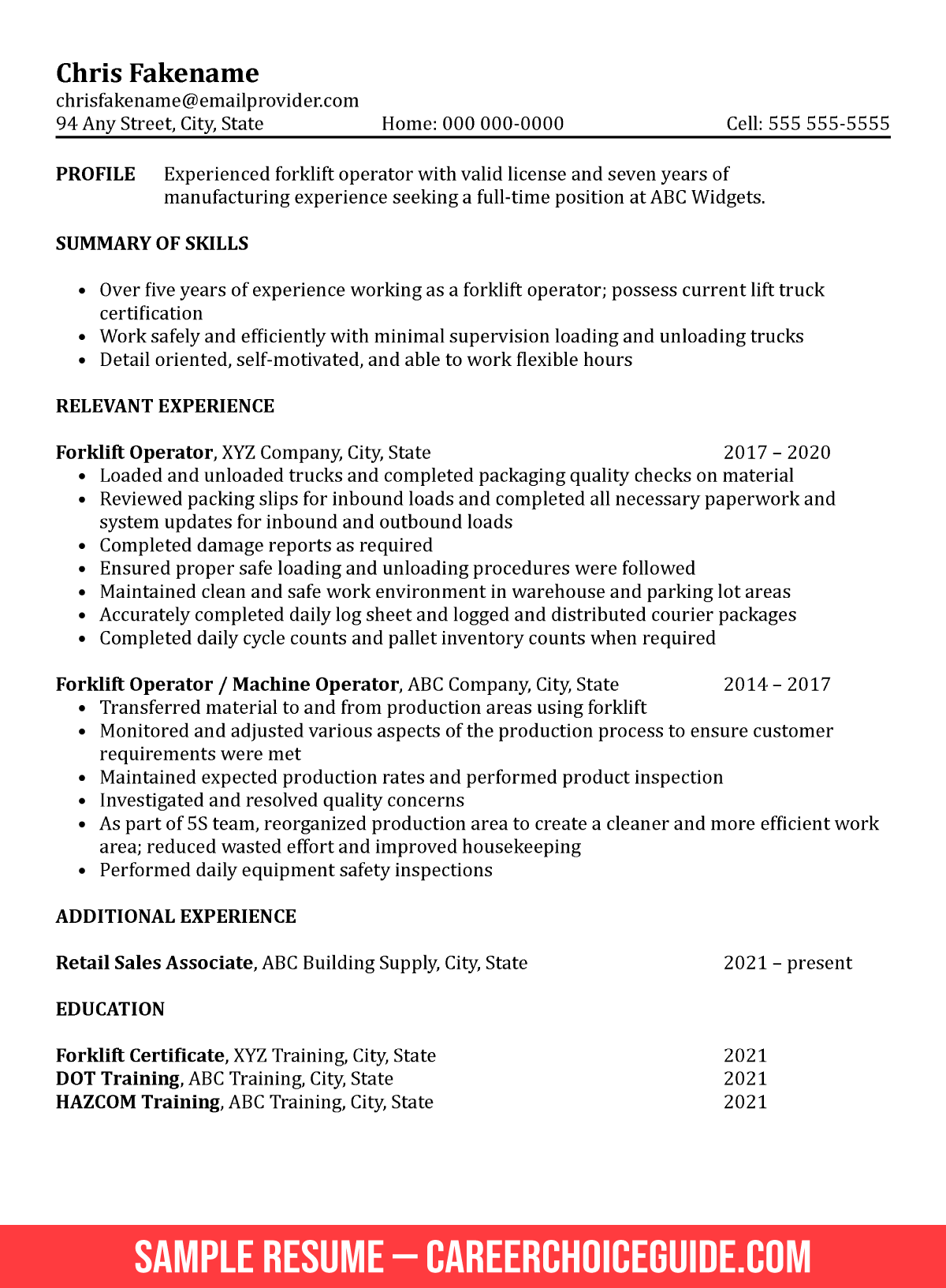
Here's Why This Forklift Operator Resume Works
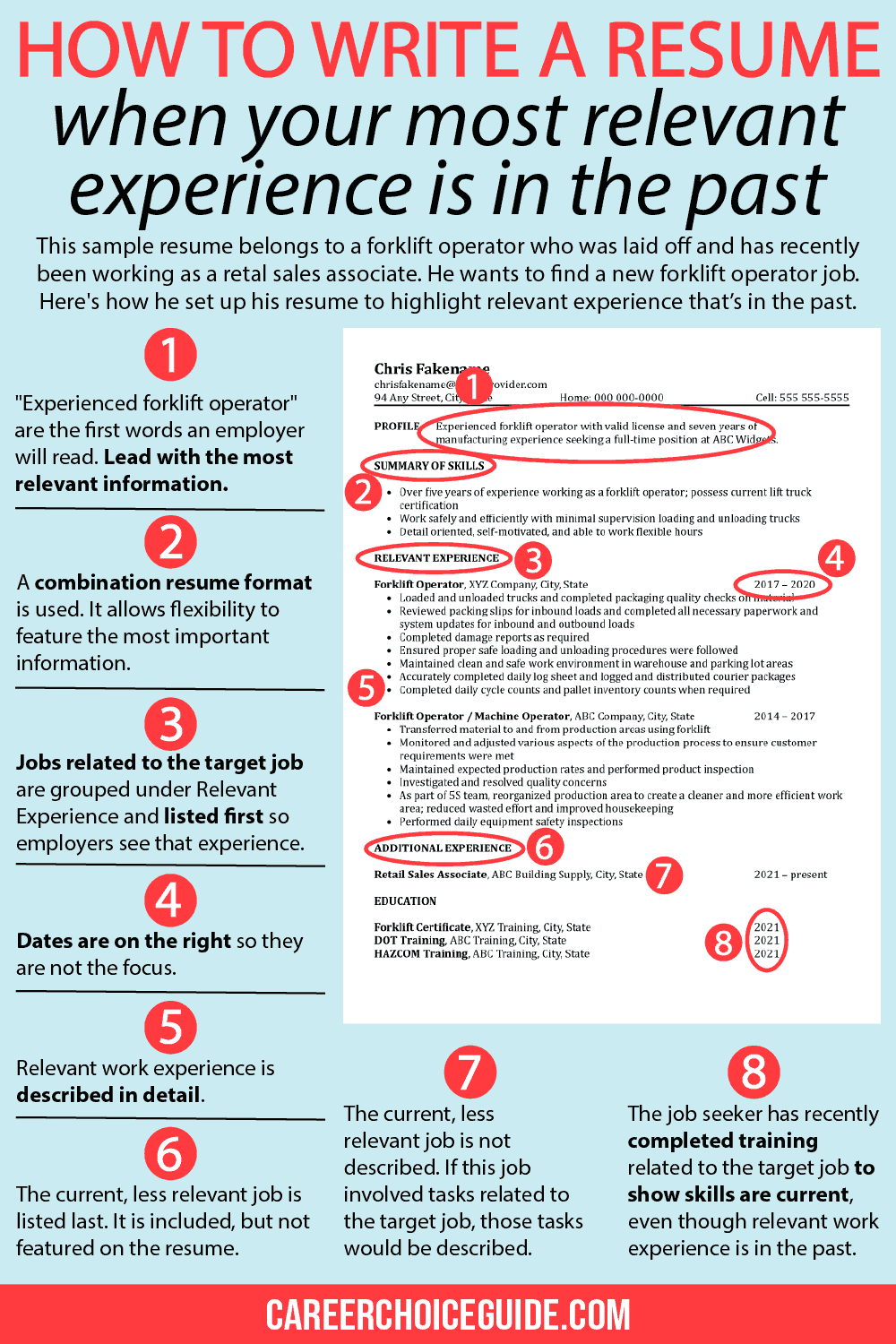
The numbered comments that follow correspond with the numbered sections of the forklift operator resume sample pictured above and provide more detailed explanations about the choices made when writing and formatting this resume.
1. Name the target job in your profile.
This job seeker is currently working as a retail sales associate, but he has several years of experience working as a forklift operator, and he is targeting that job with this resume. He lists his experience as a forklift driver and notes that his license is current. Employers can immediately begin to see him as a suitable candidate for that type of job.
2. Use a combination resume.
A combination resume includes a summary of skills section before work history. This format is ideal for anyone who wants to highlight a few key skills before describing their work history.
If your most relevant experience is in the past, a summary of skills provides an excellent opportunity to bring key accomplishments and skills to the top of your resume, where employers will see them.
3. Bring the most relevant jobs to the top of your resume.
This job seeker is not currently working in the job the resume is targeting, but he has recently worked in that job. To get his experience as a forklift operator up to the top of his work history, where the employer will see it, he has grouped both of those jobs under the Related Experience heading.
4. De-emphasize dates.
Dates are listed on the right, where they are less conspicuous. This job seeker wants employers reading his resume to focus on job titles that show he has relevant experience, so they are listed in bold and on the left side of the page.
He has also omitted months from his work history. Employers typically do not expect you to include months in this section, and for most job seekers, including months shows any gaps that exist in your work history.
5. Describe relevant work experience in detail.
Experience related to the target job is described in detail on this example resume.
6. List, but don't highlight, a current, less relevant job.
This job seeker has listed his current job. Although the job is not particularly relevant to the target job, omitting this experience would create a gap in his work history, so it needs to be included on the resume.
7. Avoid describing experience unrelated to the target job.
The less relevant job was not described on the sample resume. If this job seeker was currently working in the warehouse of a building supply store, operating a forklift, his current job would be relevant, and, in that case, it would be placed at the top of the resume and described in some detail.
8. Find ways to make older experience more current.
To aid a return to his previous type of work, this job seeker recently completed some training and licensing related to his target job. He noted in his profile that his license was current, and he has also listed that training in the education section of his resume.
